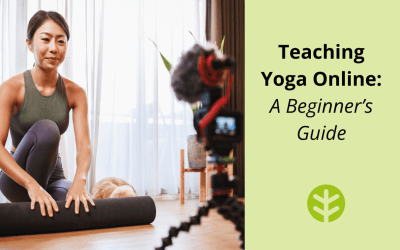Offer adjustments as you would in a class or studio: With video conferencing, you have the ability to see everyone in the “room.” If you are a yoga teacher, invite your students to turn on their cameras if they wish to receive verbal adjustments. Just as you would invite students to opt-out from adjustments in your class, do offer the option to leave cameras turned off. Not everyone will be comfortable having their personal space on display so be clear and inviting about the options to help your students feel supported in their own practice. Also, as a side note, some insurance policies require that students videos are turned on, so be aware of your policy terms in relation to this.
Consider using closed captioning in your online classes: Closed captioning is good for many reasons – not just for clients with hearing impairments but also clients that prefer reading instructions, or miss instruction from you and then can see it on the screen. A client could have a lot of background noise in their home environment that makes it difficult to hear you without having an incredibly high volume. Closed captioning is available through most online platforms including Zoom, and they are really simple to use. Having this additional accessibility feature can really open up your classes to a new audience, or just highlight how accessible your offerings can be. There is a wonderful podcast episode on this topic by our friend Shannon Crow at The Connected Yoga Teacher podcast that walks you through the steps for this.
Implement a donation-based model: If you have the means to offer classes or services by donation, you may consider this as an option to ensure individuals in your community continue to have access to wellbeing services and tools. If you’re building a fee structure similar to what you charge for in-person offerings, you could consider a discounted or free trial period when you first launch your virtual classes. Depending on your bandwidth, you could offer both, as teachers and studios often do: regular classes for a fee and a community or donation-based option as a way of giving back. The variety provides options for more people who can benefit from your service.
Meet students and clients where they are: Of course we don’t mean that you should literally meet up with your students but consider where they might be spending their time these days. Are they more likely to look at Instagram? Or tune into Facebook Live? Perhaps they are balancing working from home and home-schooling children. These are all clues as to how to develop your offerings. If you’re catering to the folks with restricted time, think about if you can provide a quick 10-minute practice for them to do in the morning before everyone in their home wakes up. If you know your crowd is active on Instagram, look into Instagram Live or even IGTV.
Get creative with props: Depending on your modality, your students might need the support of props. Similar to the previous point, consider what your clients have access to in their homes. For blocks, could they use a pack of La Croix or sturdy books? Or, instead of a bolster, how about some tightly rolled-up bath towels? A t-shirt could be repurposed as a strap. Encourage your students to be creative and reinforce the idea that they don’t need fancy equipment in order to stick to their practice.
Be mindful of space: If you have a large space to practice in, great! But, bear in mind that many people will be limited to a smaller space in a bedroom, office, or corner in a living room. They also might be negotiating space with family members and pets so keep these considerations in mind while you’re developing sequences or exercises.
Looking for further resources about how to bring your professional practice online? Be sure to check out our new ebook, your step-by-step guide to running events and classes online. To learn more about how OfferingTree can help you grow, visit us at www.OfferingTree.com.








